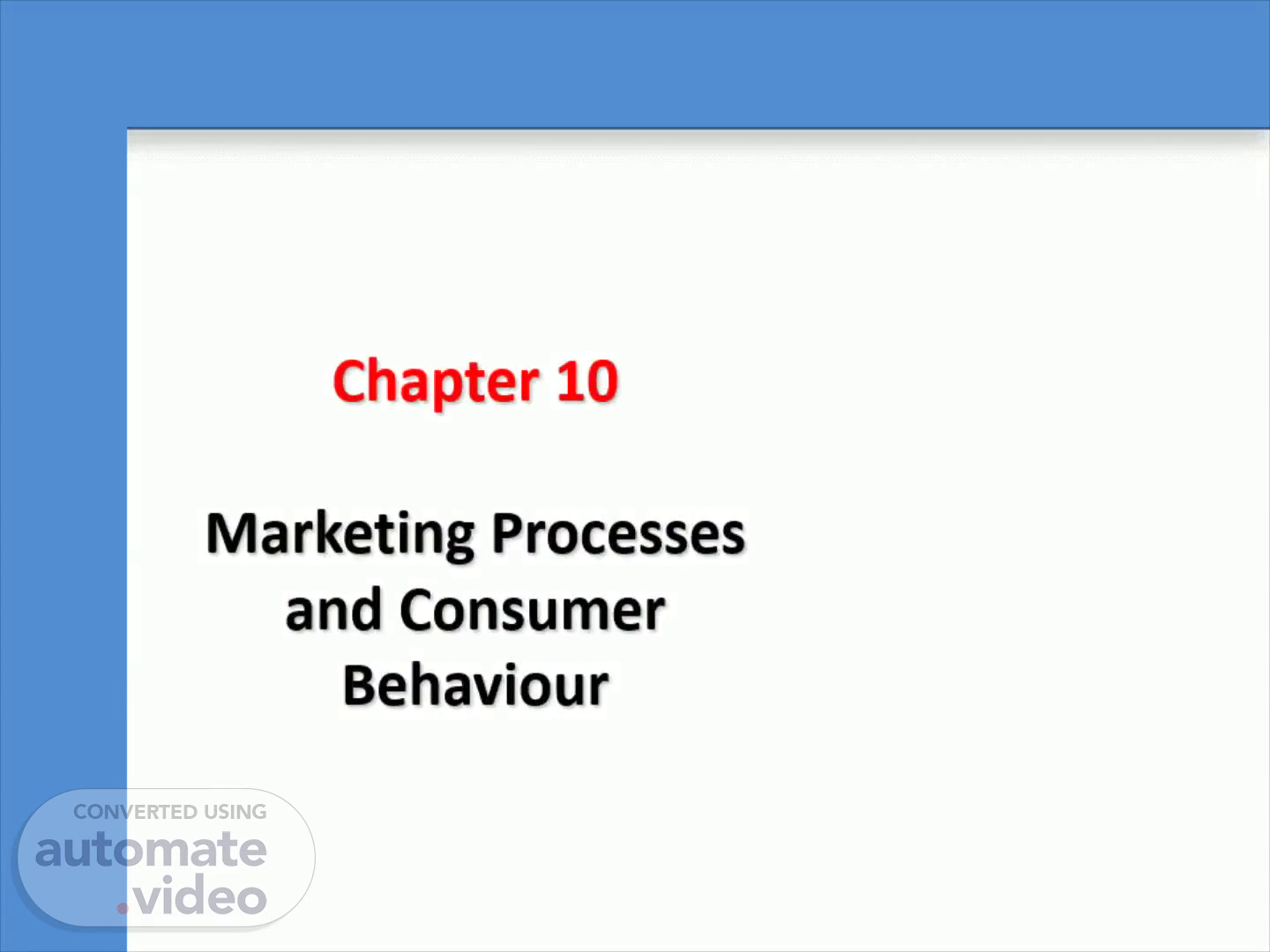
Chapter 10 Marketing Processes and Consumer Behaviour
Scene 1 (0s)
Chapter 10 Marketing Processes and Consumer Behaviour.
Scene 2 (7s)
After reading this chapter, you should be able to:.
Scene 3 (34s)
What Is Marketing?. Marketing organisational function and a set of processes for creating, communicating, and delivering value to customers, and for managing customer relationships in ways that benefit the organisation and its stakeholders.
Scene 4 (47s)
Delivering Value. Copyright © 2020 Pearson Education, Inc. publishing as Prentice Hall.
Scene 5 (1m 5s)
Delivering Value. A company may: develop an entirely new product that performs better than existing products keep a store open longer hours during a busy season offer price reductions offer information that explains how a product can be used in new ways.
Scene 6 (1m 21s)
Value and Utility. Copyright © 2020 Pearson Education, Inc. publishing as Prentice Hall.
Scene 7 (1m 38s)
Goods, Services, and Ideas. Copyright © 2020 Pearson Education, Inc. publishing as Prentice Hall.
Scene 8 (1m 54s)
Relationship Marketing. Relationship Marketing marketing strategy that emphasizes building lasting relationships with customers and suppliers.
Scene 9 (2m 3s)
The External Marketing Environment. Copyright © 2020 Pearson Education, Inc. publishing as Prentice Hall.
Scene 10 (2m 15s)
Political and Legal Environment. Copyright © 2020 Pearson Education, Inc. publishing as Prentice Hall.
Scene 11 (2m 28s)
Social and cultural environment. Copyright © 2020 Pearson Education, Inc. publishing as Prentice Hall.
Scene 12 (2m 39s)
Technological environment. Copyright © 2020 Pearson Education, Inc. publishing as Prentice Hall.
Scene 13 (2m 48s)
Economic environment. Copyright © 2020 Pearson Education, Inc. publishing as Prentice Hall.
Scene 14 (3m 5s)
Competitive Environment. Substitute product competition -product dissimilar to those of competitors but fulfill the same need. Brand competition -occurs between similar products, e.g. auditing services provided by Ernst & Young and KPMG. International competition -competitive marketing of domestic products against foreign products.
Scene 15 (3m 23s)
Strategy: The Marketing Mix. Marketing Plan detailed strategy for focusing marketing efforts on consumers’ needs and wants Marketing Mix combination of product, pricing, promotion, and place (distribution) strategies used to market products.
Scene 16 (3m 37s)
Strategy: The Marketing Mix. Product good, service, or idea that is marketed to fill consumers’ needs and wants Product Differentiation creation of a product feature or product image that differs enough from existing products to attract customers.
Scene 17 (3m 50s)
Strategy: The Marketing Mix. Pricing process of determining the best price at which to sell a product Place (Distribution) part of the marketing mix concerned with getting products from producers to consumers Promotion aspect of the marketing mix concerned with the most effective techniques for communicating information about products.
Scene 18 (4m 5s)
Target Marketing and Market Segmentation. Target Market group of people who have similar wants and needs and can be expected to show interest in the same products.
Scene 19 (4m 22s)
Identifying Market Segments. Geographic Variables geographic units that may be considered in developing a segmentation strategy Demographic Variables characteristics of populations that may be considered in developing a segmentation strategy.
Scene 20 (4m 36s)
Identifying Market Segments. Psychographic Variables consumer characteristics, such as lifestyles, opinions, interests, and attitudes that may be considered in developing a segmentation strategy.
Scene 21 (4m 47s)
Demographic Variables. Copyright © 2020 Pearson Education, Inc. publishing as Prentice Hall.
Scene 22 (5m 23s)
Understanding Consumer Behaviour. Consumer Behaviour study of the decision process by which people buy and consume products.
Scene 23 (5m 35s)
Influences on Consumer Behaviour. Psychological Personal Social Cultural.
Scene 24 (5m 43s)
Influences on Consumer Behaviour. Psychological influences include an individual’s motivations, perceptions, ability to learn, and attitudes Personal influences include lifestyle, personality, and economic status Social influences include family, opinion leaders, friends, colleagues Cultural influences include culture and social class (background, occupation, income).
Scene 25 (6m 2s)
What Is a Product?. Product Features tangible and intangible qualities that a company builds into its products Value Package product marketed as a bundle of value-adding attributes, including reasonable cost.
Scene 26 (6m 16s)
Categories of Consumer Products. Copyright © 2020 Pearson Education, Inc. publishing as Prentice Hall.
Scene 27 (6m 40s)
Organizational Products. Copyright © 2020 Pearson Education, Inc. publishing as Prentice Hall.
Scene 28 (7m 4s)
The Product Mix. Product Mix group of products that a firm makes available for sale Example: Nestle – grocery (milo, maggie), confec(chocolate, kit-kat), ice-cream, chill (yogurt ) Product Line group of products that are closely related because they function in a similar manner or are sold to the same customer group who will use them in similar ways. e.g. - Nescafe—rich, regular, mild.
Scene 29 (7m 27s)
Developing New Products. The New Product Development Process Research and development (R&D) Departments for exploring new product possibilities Product mortality rates Few product ideas (1 in 50) actually reach the market Speed to market Responding to customer demand or market changes by introducing new products to the market ahead of competitors.
Scene 30 (7m 43s)
Product Life Cycle. Product Life Cycle (PLC) series of stages in a product’s commercial life introduction, growth, maturity, decline.
Scene 31 (7m 58s)
Product Life Cycle. Copyright © 2020 Pearson Education, Inc. publishing as Prentice Hall.